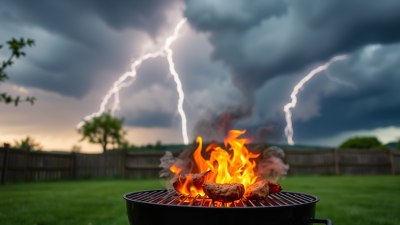What the Weather Says About Your Relationship Style
Explore how different weather patterns reflect and influence your relationship style.

The weather can have a profound impact on our emotions, moods, and ultimately, our relationships. Understanding the connection between weather patterns and relationship styles can provide invaluable insights into how partners interact with each other. Whether it’s the warmth of summer or the chill of winter, each season reflects a unique approach to love and connection.
Spring: Renewal and Growth
Springtime symbolizes renewal and growth, often leading couples to rejuvenate their love for one another. As the flowers bloom and the weather warms, many people feel more optimistic and open to new experiences. Relationships during this season often exhibit traits such as spontaneity, excitement, and a joyful embrace of change. Couples in spring typically engage in outdoor activities, explore new ventures together, or embark on romantic getaways. This season encourages partners to communicate effectively about their hopes and dreams, fostering an environment where both partners feel inspired to grow together.
Summer: Passion and Fun
Summer embodies a fiery passion, warmth, and adventure - characteristics that can strongly influence relationship styles. Couples who align with the summer season often embrace spontaneity and adventure, leading to a relationship filled with laughter and fun. This vibrant energy can manifest in weekend trips to the beach, spontaneous road trips, or outdoor festivals that bring partners closer together. However, with this enthusiasm can also come challenges as the intensity of summer can create heat that sometimes leads to conflict. Partners must learn to temper their fiery exchanges and find common ground amidst the excitement. Embracing effective communication during turbulent moments is crucial in this season of passion.
Autumn: Reflection and Intimacy
As the leaves turn and the air becomes crisp, autumn invites couples to reflect on their relationship's depth. This season often encourages partners to focus on intimacy and emotional connection. Couples may find themselves retreating into cozy indoor activities, such as cooking together or enjoying quiet evenings by the fireplace. With the world transitioning, partners may also engage in discussions about their future, nurturing a deeper understanding of one another. The reflective nature of autumn helps couples evaluate their relationship's trajectory, making adjustments as needed to ensure they’re on the right path. It’s a time when vulnerability can flourish, and partners can bond over shared hopes and fears.
Winter: Challenges and Resilience
Winter can be a challenging season for relationships, mimicking the cold and often harsh conditions outside. Couples may face obstacles, such as limited outdoor activities and the temptation to retreat into solitude. However, winter also offers an opportunity for partners to build resilience and fortitude within their relationship. Those that thrive in this season often focus on strengthening their emotional bonds through deep conversations, shared struggles, and the establishment of traditions that keep the relationship warm. Building resilience during winter can mean learning to communicate effectively about challenges, practicing patience, and being supportive of each other's mental health. Couples who embrace these aspects can emerge from winter stronger and more connected than ever.
Weathering the Storms: The Impact of Rain
Rainy days often symbolize conflict and emotional turmoil within relationships. Just as storms can be sudden and intense, conflicts between partners can arise out of nowhere. How couples handle these storms can reveal a lot about their relationship style. Partners who can effectively communicate and support one another during these turbulent times typically emerge with stronger bonds. On the other hand, couples that hide from the storms may find themselves struggling with unresolved issues. Using storms as an opportunity to open dialogues about feelings, boundaries, and expectations can transform rainy days into moments of growth and closeness.
Sunny Days: Happiness and Connection
Sunny days symbolize happiness and clarity, often fostering an environment where relationships can thrive. During these idyllic moments, partners find it easier to connect and share joyous experiences. The positive energy brought by such weather can lead to meaningful conversations and shared adventures that strengthen the bond between partners. It’s essential for individuals to recognize that while sunny days are wonderful, they also need to be mindful of their partner's feelings and challenges. Oftentimes, we need to recognize the importance of being present for one another, both in happy times and during more challenging weather.
Understanding Your Personal Climate
Just as the weather varies across the globe, so does each individual’s relationship style. It’s important to assess your personal climate and how it affects your interactions with your partner. Some may naturally lean towards hot and passionate relationships, while others may prefer a cool, calm, and collected approach. Understanding your own relationship style—and that of your partner—can help bridge gaps and enhance compatibility. Consider discussing your emotional responses to different weather patterns together; it can lead to enlightening conversations about your preferences and needs.
Adapting to Change: Embracing Seasonal Transitions
Relationships are dynamic and will inevitably undergo seasonal changes. Just as the weather shifts from one season to another, couples must learn to adapt to these changes. Seasonal transitions can signify new phases in the relationship, such as becoming parents, moving in together, or experiencing significant life changes. Embracing these transitions together can foster deeper connections and understanding, as couples share the experience of navigating new challenges and celebrating milestones. By viewing these shifts in perspective positively, partners can work together to breathe new life into their relationship.
The Role of Individual Differences
It’s essential to recognize that individual differences can play a significant role in how couples respond to varying weather patterns. Personality traits, past experiences, and cultural backgrounds can shape how one views relationships. For example, someone who thrives in the heat might find it easier to build deep connections, while another may prefer a more laid-back, cool approach. It’s valuable for couples to communicate openly about these differences and navigate through them together. Engaging in discussions about personal climate preferences can help couples celebrate their uniqueness and find harmony together.
Embrace Your Weather-Based Style
Understanding how the weather can influence your relationship style allows you to appreciate the connections between your emotional responses and your partner’s behaviors. By observing the seasons and how they mirror your relationship dynamics, you can not only strengthen your bond but also grow as individuals. Ultimately, every relationship has its unique climate; embracing the beauty of those differences can lead to a more fulfilling, resilient partnership. Just as we cannot control the weather, we cannot fully control our relationships either, but we can adapt, acknowledge, and cherish each chapter as it comes.











